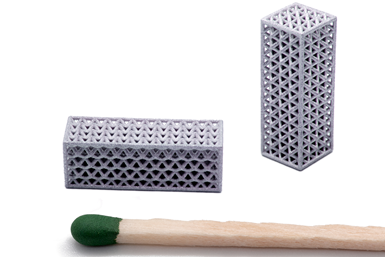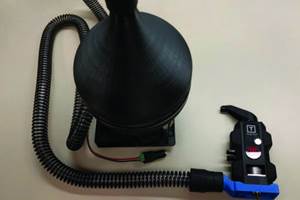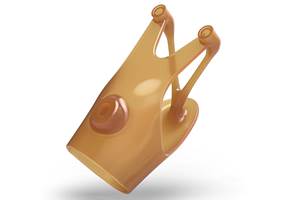Students Use Micro Metal 3D Printing for ISS Microgravity Experiment
Qualified3D printed lattice parts for the students using microstereolithography (micro SLA), which seemed to be the only process able to produce the parts with sufficient accuracy.
Stainless steel microlattice structures developed by VCS for an experiment on capillary action in microgravity on the International Space Station. Photo Credit:
When a team of high school students from the International Space Station Research (ISS) National Lab program at Valley Christian School (VCS) in San Jose, California, needed millimeter-scale lattices for an experiment on capillary action in microgravity, they turned to Qualified3D to get parts printed using microstereolithography (micro SLA).
Led by students Rohan Sachdeva and Daisy Zeng, the team designed lattices that had struts as thin as 0.5 mm in diameter, and micro SLA seemed to be the only process able to produce parts with sufficient accuracy.
While dimensionally precise, parts made from photopolymer resin were not an ideal match for the requirements of space flight due to their lack of resistance to vibrations, low temperatures and heat. Metal offered a better set of properties for the ISS experiment, but, unfortunately, the lattice design was not printable with conventional metal powder bed fusion and binder jetting 3D printing technologies.
Enter lithography-based metal manufacturing (LMM), a new 3D printing process which utilizes the principle of photopolymerization — where a metal powder is dispersed in a photosensitive resin and selectively polymerized by a Digital Light Processing (DLP) projector. This technology is capable of producing parts with extremely thin walls (125 microns) and smooth surfaces (2-5 micron surface roughness before polishing) in a variety of metals, including stainless steel and titanium.
Germany-based startup Metshape is recognized globally for its expertise in 3D printing and sintering LMM micro parts. It also sells its services to U.S. customers through Qualified3D. “Some of our students discovered that the miniature lattice design was printable using the LMM technology and proactively reached out to them,” says Emeka Okekeocha, ISS Program Manager at VCS. “After a technical review, we accepted the proposed change from acrylate resin to stainless steel.”
The students in the ISS Research Lab received their parts within a few weeks and are now looking forward to putting them to use for their experiment in microgravity. The experiment package should be launched up to the ISS in mid-February 2023 and should begin returning data in March 2023.
“We are very thankful to Qualified3D for how they always quickly responded to our requests and questions,” says David Kou, an 11th grade member of the VCS team. “Even with the many changes we requested, the parts were still delivered on time, which helped us to transition smoothly between planning and building our microgravity experiment.”
On a broader level, controlled capillarity in 3D printed metallic lattices is expected to open new technical possibilities in future outer space applications such as gas filtration, aerosol sample collection and temperature management. Another application is being able to passively control where water is in a container because, without this technology, it would be difficult to predict the location of the water in microgravity which has applications in plant growth.
- Listen to this episode of AM Radio to learn how 3D printing applications are playing a role in space exploration.
- Six reasons why space exploration will need additive manufacturing.
Related Content
Chromatic RX-Flow 3D Printers for Reactive Extrusion Additive
RX-Flow printers are a low-cost option for manufacturers interested in testing and implementing industrial 3D printing with more durable, flexible materials than are available with FDM, SLA and other 3D printing technologies.
Read MoreNIOSH Publishes 3D Printing Safety Guide for Nonindustrial Settings
NIOSH has published a 3D printing safety guide for small businesses and other additive manufacturing users such as makerspace users, schools, libraries and small businesses.
Read MoreLouisville Slugger Uses Formlabs Technology to Accelerate Innovation
Louisville Slugger relies on Formlabs’ Form 3 stereolithography 3D printer to create both prototypes and manufacturing aids for designs of the composite and aluminum bats swung by youth and collegiate players.
Read More3D Systems’ Accura AMX Resin Withstands Harsh Thermal Environments
Formnext 2023: The resin material is well suited for the testing of high-temperature components in applications such as HVAC, consumer appliances, motor enclosures, fixtures, mounts, stators, molding/tooling and more.
Read MoreRead Next
3D Printing Brings Sustainability, Accessibility to Glass Manufacturing
Australian startup Maple Glass Printing has developed a process for extruding glass into artwork, lab implements and architectural elements. Along the way, the company has also found more efficient ways of recycling this material.
Read MoreGE Additive Rebrands as Colibrium Additive
As part of the brand name transition, both the Concept Laser and Arcam EBM legacy brands will be retired.
Read MoreLooking to Secure the Supply Chain for Castings? Don't Overlook 3D Printed Sand Cores and Molds
Concerns about casting lead times and costs have many OEMs looking to 3D print parts directly in metal. But don’t overlook the advantages of 3D printed sand cores and molds applied for conventional metal casting, says Humtown leader.
Read More













.png;maxWidth=300;quality=90)










